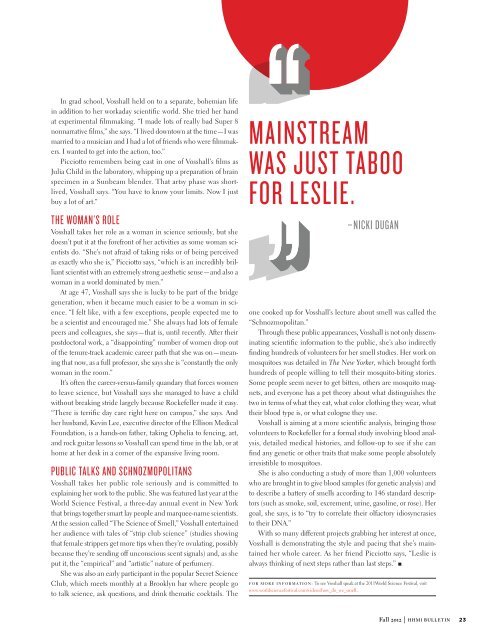Download PDF - Howard Hughes Medical Institute
Download PDF - Howard Hughes Medical Institute
Download PDF - Howard Hughes Medical Institute
Create successful ePaper yourself
Turn your PDF publications into a flip-book with our unique Google optimized e-Paper software.
In grad school, Vosshall held on to a separate, bohemian life<br />
in addition to her workaday scientific world. She tried her hand<br />
at experimental filmmaking. “I made lots of really bad Super 8<br />
nonnarrative films,” she says. “I lived downtown at the time—I was<br />
married to a musician and I had a lot of friends who were filmmakers.<br />
I wanted to get into the action, too.”<br />
Picciotto remembers being cast in one of Vosshall’s films as<br />
Julia Child in the laboratory, whipping up a preparation of brain<br />
specimen in a Sunbeam blender. That artsy phase was shortlived,<br />
Vosshall says. “You have to know your limits. Now I just<br />
buy a lot of art.”<br />
The Woman’s Role<br />
Vosshall takes her role as a woman in science seriously, but she<br />
doesn’t put it at the forefront of her activities as some woman scientists<br />
do. “She’s not afraid of taking risks or of being perceived<br />
as exactly who she is,” Picciotto says, “which is an incredibly brilliant<br />
scientist with an extremely strong aesthetic sense—and also a<br />
woman in a world dominated by men.”<br />
At age 47, Vosshall says she is lucky to be part of the bridge<br />
generation, when it became much easier to be a woman in science.<br />
“I felt like, with a few exceptions, people expected me to<br />
be a scientist and encouraged me.” She always had lots of female<br />
peers and colleagues, she says—that is, until recently. After their<br />
postdoctoral work, a “disappointing” number of women drop out<br />
of the tenure-track academic career path that she was on—meaning<br />
that now, as a full professor, she says she is “constantly the only<br />
woman in the room.”<br />
It’s often the career-versus-family quandary that forces women<br />
to leave science, but Vosshall says she managed to have a child<br />
without breaking stride largely because Rockefeller made it easy.<br />
“There is terrific day care right here on campus,” she says. And<br />
her husband, Kevin Lee, executive director of the Ellison <strong>Medical</strong><br />
Foundation, is a hands-on father, taking Ophelia to fencing, art,<br />
and rock guitar lessons so Vosshall can spend time in the lab, or at<br />
home at her desk in a corner of the expansive living room.<br />
Public Talks and Schnozmopolitans<br />
Vosshall takes her public role seriously and is committed to<br />
explaining her work to the public. She was featured last year at the<br />
World Science Festival, a three-day annual event in New York<br />
that brings together smart lay people and marquee-name scientists.<br />
At the session called “The Science of Smell,” Vosshall entertained<br />
her audience with tales of “strip club science” (studies showing<br />
that female strippers get more tips when they’re ovulating, possibly<br />
because they’re sending off unconscious scent signals) and, as she<br />
put it, the “empirical” and “artistic” nature of perfumery.<br />
She was also an early participant in the popular Secret Science<br />
Club, which meets monthly at a Brooklyn bar where people go<br />
to talk science, ask questions, and drink thematic cocktails. The<br />
Mainstream<br />
WAs just taboo<br />
for Leslie.<br />
FOR MORE INFORMATION: To see Vosshall speak at the 2011World Science Festival, visit<br />
www.worldsciencefestival.com/videos/how_do_we_smell.<br />
–Nicki Dugan<br />
one cooked up for Vosshall’s lecture about smell was called the<br />
“Schnozmopolitan.”<br />
Through these public appearances, Vosshall is not only disseminating<br />
scientific information to the public, she’s also indirectly<br />
finding hundreds of volunteers for her smell studies. Her work on<br />
mosquitoes was detailed in The New Yorker, which brought forth<br />
hundreds of people willing to tell their mosquito-biting stories.<br />
Some people seem never to get bitten, others are mosquito magnets,<br />
and everyone has a pet theory about what distinguishes the<br />
two in terms of what they eat, what color clothing they wear, what<br />
their blood type is, or what cologne they use.<br />
Vosshall is aiming at a more scientific analysis, bringing those<br />
volunteers to Rockefeller for a formal study involving blood analysis,<br />
detailed medical histories, and follow-up to see if she can<br />
find any genetic or other traits that make some people absolutely<br />
irresistible to mosquitoes.<br />
She is also conducting a study of more than 1,000 volunteers<br />
who are brought in to give blood samples (for genetic analysis) and<br />
to describe a battery of smells according to 146 standard descriptors<br />
(such as smoke, soil, excrement, urine, gasoline, or rose). Her<br />
goal, she says, is to “try to correlate their olfactory idiosyncrasies<br />
to their DNA.”<br />
With so many different projects grabbing her interest at once,<br />
Vosshall is demonstrating the style and pacing that she’s maintained<br />
her whole career. As her friend Picciotto says, “Leslie is<br />
always thinking of next steps rather than last steps.” W<br />
Fall 2o12 | h h m i b u l l e t i n<br />
23
















